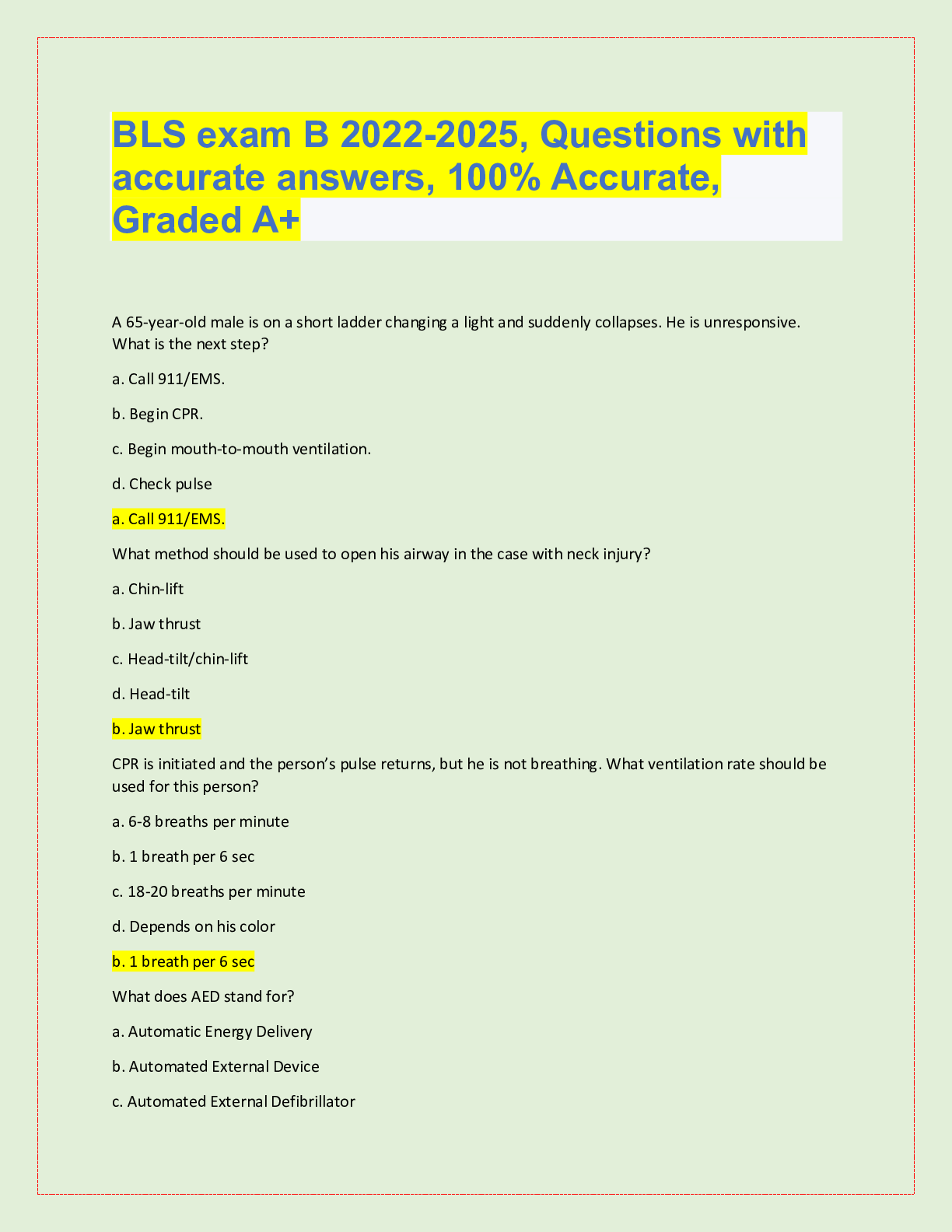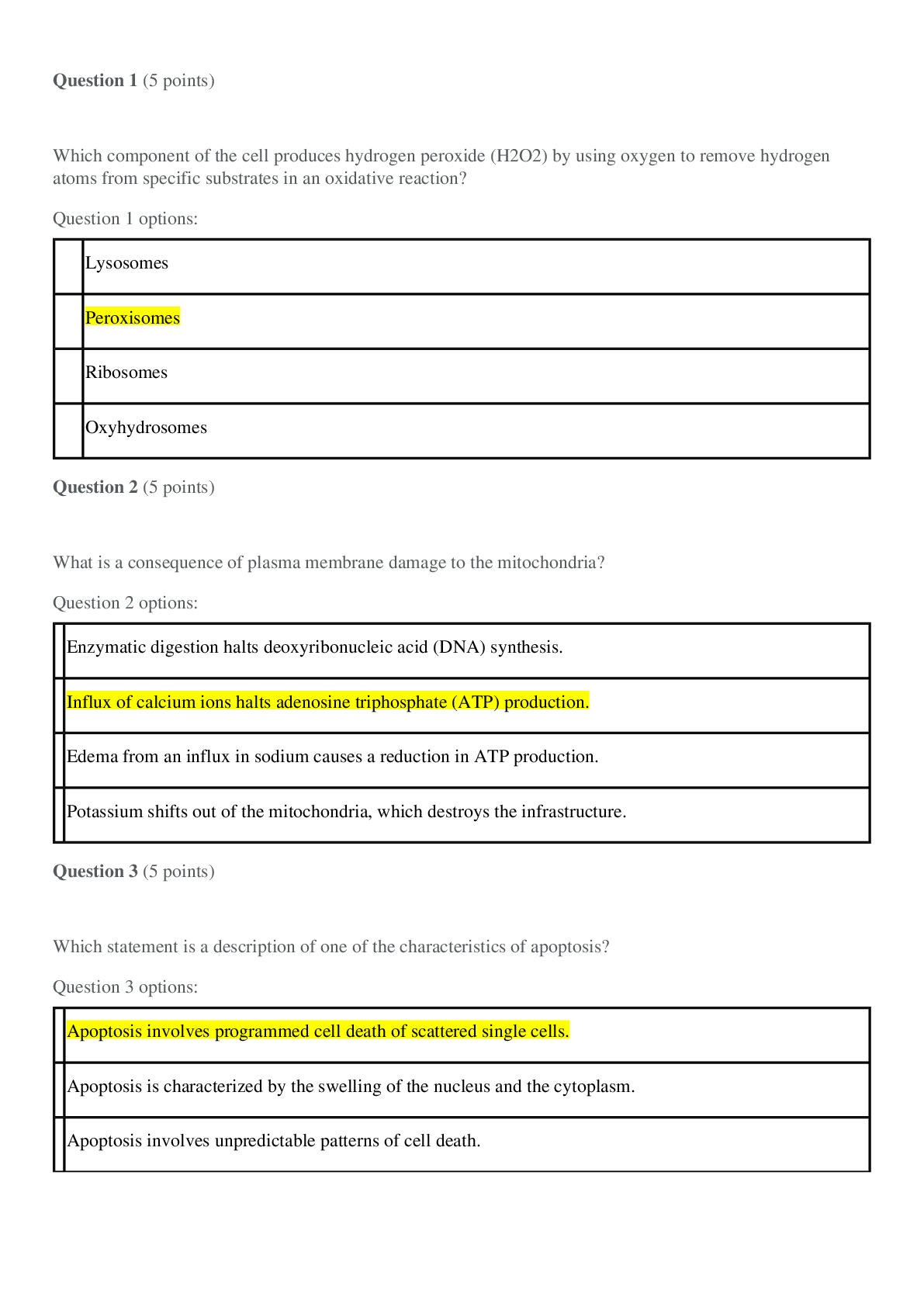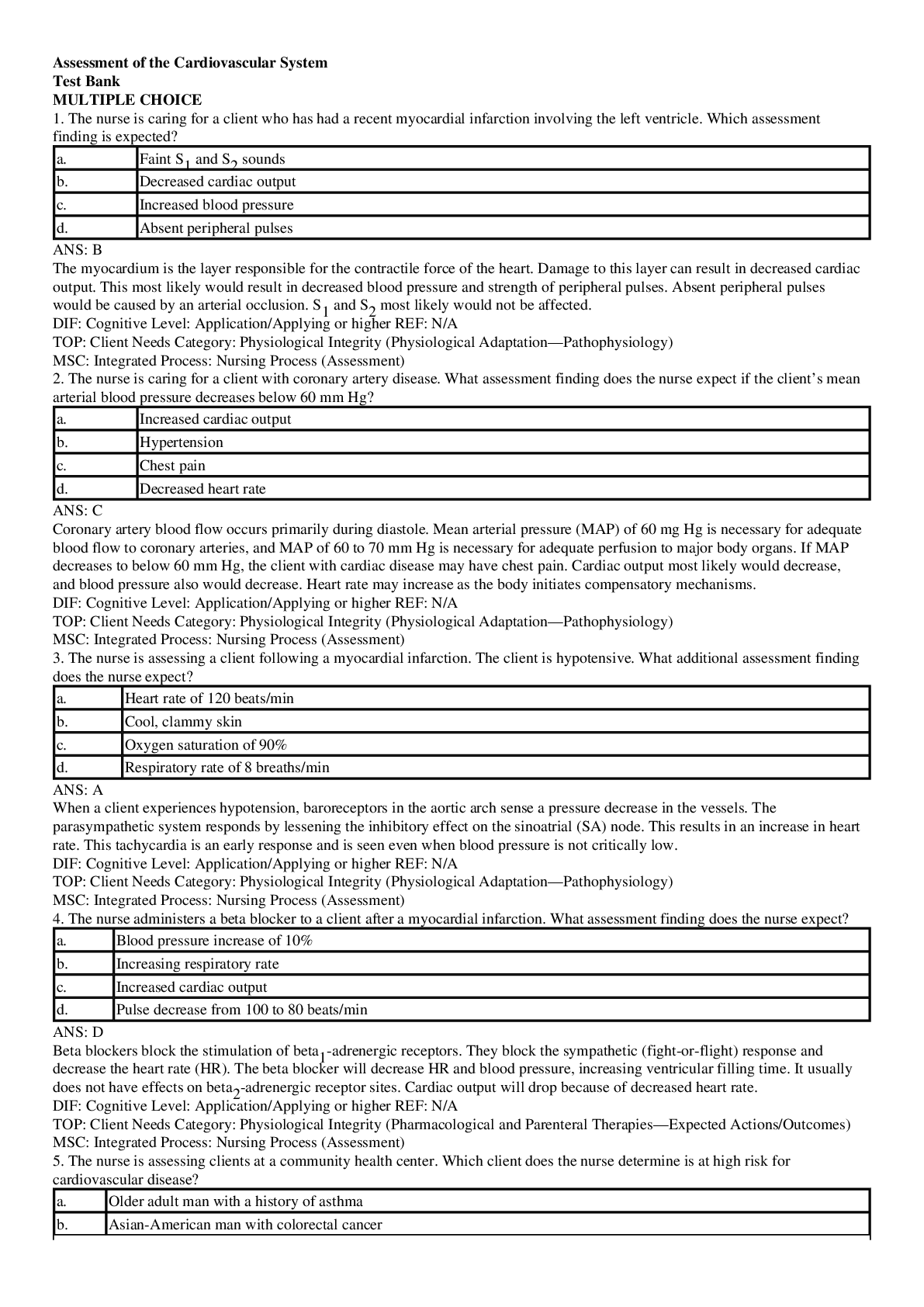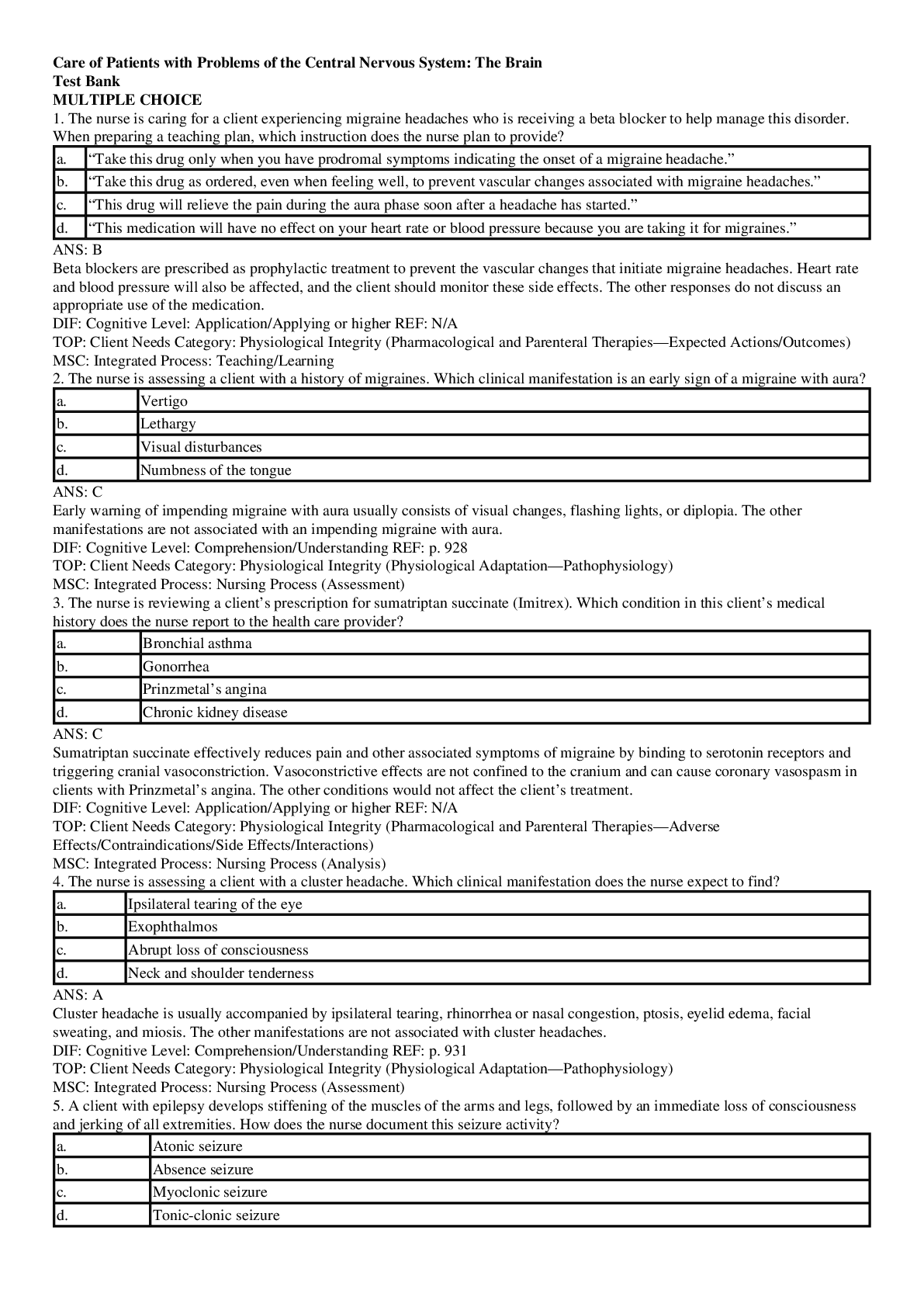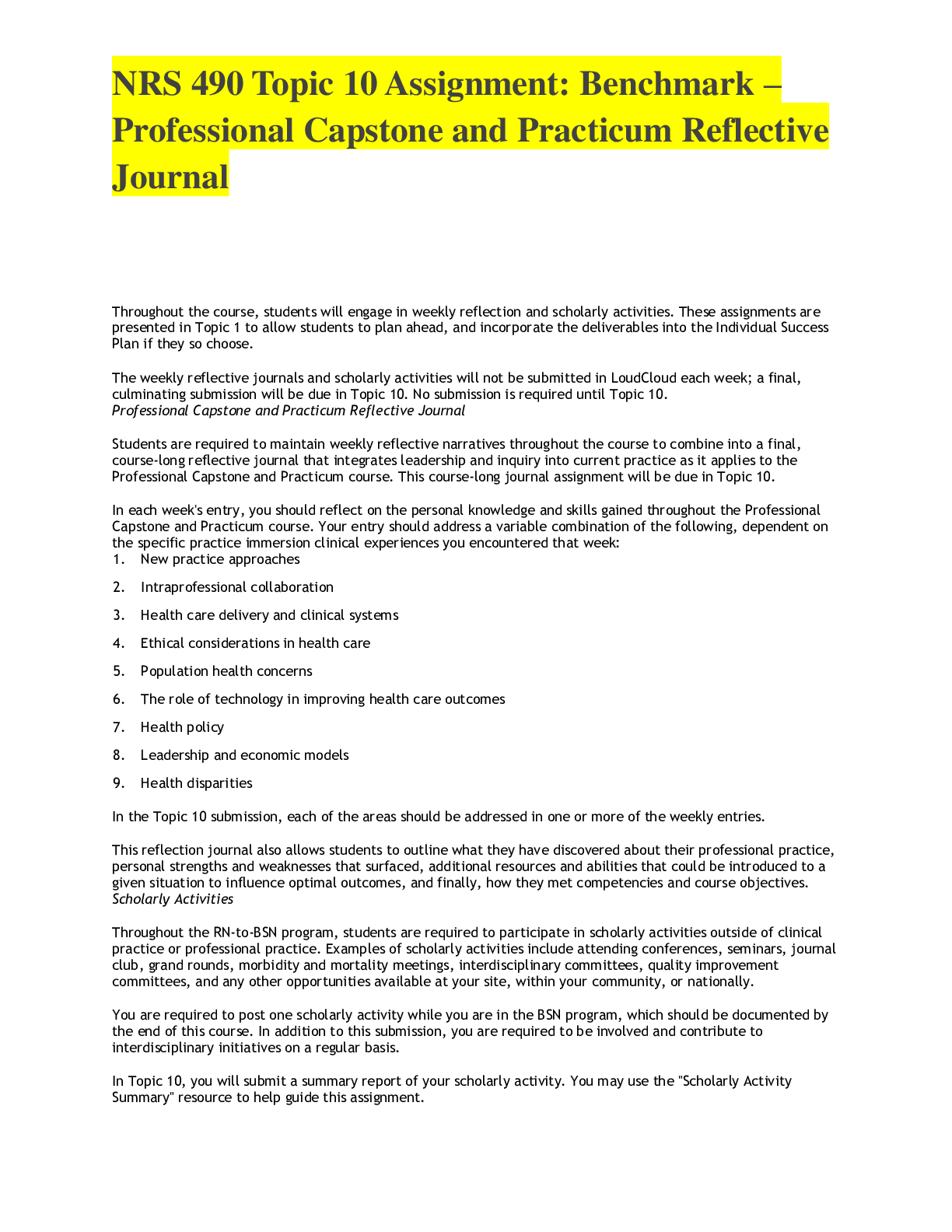Social Sciences > QUESTIONS & ANSWERS > LCSW Questions & Answers. 100% Accurate, rated A+, Questions Bank. When addressing termination of t (All)
LCSW Questions & Answers. 100% Accurate, rated A+, Questions Bank. When addressing termination of the c
Document Content and Description Below
LCSW Questions & Answers. 100% Accurate, rated A+, Questions Bank. When addressing termination of the client in a planned short-term treatment context, it should FIRST be discussed with the clien... t: A) In the beginning of treatment B) In the middle of treatment C) At the end of treatment D) Generally, not discussed until termination - ✔✔-A) In the beginning of treatment Key words: addressing termination, planned short-term treatment, first discussed In planned short-term, time limits and planned termination are essential to the practice structure. # of treatment sessions usually established in the first session. The termination process is most commonly associated with: A) Evaluating goals and accomplishments B) Implementing a plan of action C) Setting limits D) Developing a contract - ✔✔-A) Evaluating goals and accomplishments Key Words: termination process, commonly associated A family with a teenage girl brings their daughter in for counseling due to suspected substance abuse. The daughter is defiant and says it is her parents who need help and she refuses any intervention. What should the social worker due first? A) Refer the daughter for substance abuse counseling B) Explain to the parents that her attitude is typical for her age C) Assist the daughter to express her anger with her parents D) Explore and clarify what the problem is that will need to be addressed - ✔✔-D) Explore and clarify what the problem is that will need to be addressed Key Words: Suspected substance abuse. Option A - referral is for counseling, not drug testing. A social worker is working with a client that is female and a single-parent mother with three small children. When referring this client in the community for service, the most important information for the social worker to discuss with the client is: A) The agency's reputation in the human service community B) Appropriateness of the agency service to meet the client's needs C) Fees the agency will charge the client for services D) Ease with which the client can reach the agency from home or work - ✔✔-B) Appropriateness of the agency service to meet the client's needs While all choices may be relevant at some point, appropriateness of the agency to address the problem is essential. Other factors are secondary distracters. Which of the following tasks most appropriately describes the activities of a social worker in the role of community organizer? A) Determining the redistribution of scarce resources within a community B) Enacting legislation that strengthens the funding of a community program C) Collecting data on social welfare programs and suggesting strategies for improvement D) Developing and working with groups from a community to improve relationships among the residents - ✔✔-D) Developing and working with groups from a community to improve relationships among the residents The basics of social work & community organization in the practice community require the social worker to be active working with residents of the community. Other distracters are roles that a social worker might assume, but are NOT typical of the traditional role. A 15-year-old male teenager is angry with his father. He cannot tell his father how he feels. He plays football and during practice he deliberately tackles a member of the other team, fiercely knocking the other player to the ground. While charging the other player, he is thinking about his father and the anger he has for him. This is an example of: A) Sublimation B) Displacement C) Reaction Formation D) Projection - ✔✔-A) Sublimation The individual deals with emotional conflict or internal or external stressors by channeling potentially maladaptive feelings or impulses into socially acceptable behavior. (e.g. contact sports to channel angry impulses) A client discusses with the social worker a fight she had with her husband. The client explains how angry she was with her husband, but the husband abruptly left the house and ended the fight. The client reported she was still furious with him. Since she had to hurry and get her daughter ready for school, she wildly brushed the child's hair until the child complained it hurts. The mother is expressing her anger with the father while combing the child's hair roughly. This is an example of: A) Sublimation B) Displacement C) Reaction Formation D) Projection - ✔✔-B) Displacement The mother is putting her anger into a safer substitute object, which, in this case, is the child's hair. A couple with two children is recently divorced. The mother is given custody of the children and the father does not visit or pay child support. When the mother tries to discipline the child, he constantly complains that his father was a better parent and would always know how to help him when needed. He complains that the mother can never understand what he is experiencing and wishes his father was still there. This is an example of: A) Rationalization B) Denial C) Idealization D) Intellectualization - ✔✔-C) Idealization In this situation, it appears the child is dealing with his loss by attributing exaggerated positive qualities to his father. L has a child who was recently diagnosed with a terminal illness. L. tells the social worker that her child is not ill and will not be returning to the clinic for follow-up. Which of the following defense mechanisms is BEST represented by L's response? A) Rationalization B) Denial C) Intellectualization D) Projective Identification - ✔✔-B) Denial This is an example of denial where the mother refuses to acknowledge the situation. A social worker is seeing an adolescent referred by his parents who are concerned about his angry outbursts related to an intense hatred for homosexuals. After several sessions with the social worker, the adolescent acknowledges having homosexual fantasies, but continues to articulate his hatred for gays. Which defense mechanism is most likely being displayed? A) Reaction Formation B) Denial C) Sublimation D) Displacement - ✔✔-A) Reaction Formation In this case, angry outbursts are being used to avoid/cover fantasy behavior and are still attached to the strong hatred. This is most likely repression that has now developed into a reaction formation. A woman does not like her neighbor (referred to as M) and is constantly yelling, arguing, fighting, and finding fault with M. She believes that all of the other neighbors living near here feel the same way about M. She tells M that the other neighbors do not like her as well. When discussing her intense feelings for M, the other neighbors are strangely silent and do not voice the same concerns. What is this client most likely experiencing? A) Projection B) Projective Identification C) Displacement D) Reaction Formation - ✔✔-A) Projection The client is dealing with her own feelings of anger toward M, and assumes everyone familiar with M feels the same way. A client is diagnosed with the eating disorder anorexia nervosa. To completely assess the client for comorbidity, the social worker should also assess for the presence of: A) Bulimia Nervosa B) Attention Deficit Hyperactivity Disorder C) Bipolar I Disorder D) Body Dysmorphic Disorder - ✔✔-D) Body Dysmorphic Disorder Often times, body dysmorphic disorder is present with anorexia nervosa, as the individual is often extremely thin, but view themselves with a perceived body flaw such as being grossly overweight. S, a 30-year-old divorced male tells his social worker that he is going to commit suicide and clearly outlines a concrete plan to complete this. What should the social worker do first? A) Complete a no-harm/no-risk agreement B) Seek hospitalization C) Complete an assessment D) Maintain confidentiality - ✔✔-B) Seek hospitalization If ideation and intent can be clearly assessed, seek admission. To diagnose intellectual disability, which one of the following is required: A) Deficits in adaptive and intellectual functioning B) An IQ score of more than 70 C) Occurs at any time during the lifespan D) Less than two standard deviations below the mean - ✔✔-A) Deficits in adaptive and intellectual functioning A child has a severe learning disability and is unable to speak. The child is being placed in a foster home. He was living with his parents, who have now been placed in jail pending criminal charges. In order to facilitate temporary placement for this client, the best course of action for the social worker is: A) Determine what tasks the client was able to complete in his previous home environment B) Determine what tasks he is able to perform for himself currently in the foster home C) Assess the current situation by examining how the child responds to verbal and non-verbal cues D) Place the child with a neighbor familiar with his condition - ✔✔-C) Assess the current situation by examining how the child responds to verbal and non-verbal cues When a client is suspected to have Tourette's disorder, the social worker's FIRST referral should be to: A) A Psychotherapist B) A Neurologist C) A Pathologist D) A long-term treatment program - ✔✔-B) A Neurologist What type of drug has not been shown to have withdrawal syndrome? - ✔✔-Hallucinogen A social worker in private practice has a first session with a teenager who was referred for recent poor school performance. He is withdrawing from friends and family, and has been found hiding under his bed. The parents have found marijuana in his room. He told the social worker in the first session that he has been hearing voices. What should the social worker do first? A) Recommend substance abuse treatment B) Refer the teenager for a substance evaluation C) Refer the teenager to a psychiatrist for a mental health assessment D) Assess the teenager for depression - ✔✔-B) Refer the teenager for a substance evaluation. J, a 40-year-old male, reports feeling depressed. Which is least likely to be a behavioral manifestation associated with his depression? A) Decreased productivity and fatigue at work B) Fear or belief in having a serious illness C) Difficulty falling or staying asleep D) Appetite changes resulting in weight loss - ✔✔-B) Fear or belief in having a serious illness (B) is not a BEHAVIORAL manifestation; fear or belief is cognitive P, an 18-year-old female generally of normal weight reports that she has recently lost 12 pounds. Family members report that on occasion, she eats large quantities of food and abruptly disappears after mealtime is complete. As of late, this behavior has become more common and is concerning to family and friends. The most likely diagnosis is: A) Atypical Eating Disorder B) Uncontrolled Dieting C) Anorexia Nervosa D) Bulimia - ✔✔-D) Bulimia Client is of normal weight, eating large quantities of food...not common in anorexia nervosa. The social worker suspects that a client on her unit who is HIV positive. It is against agency policy to disclose information to clients on the unit about other clients on the unit. What should the social worker do? A) Tell the client that the individual he is having sexual intercourse with is HIV positive B) Be sure the client is aware of HIV and the risk of having relations with someone who is HIV+ C) Tell the agency administrator about the situation D) Violate agency policy to protect your client - ✔✔-B) Be sure the client is aware of HIV and the risk of having relations with someone who is HIV+ Most important way to help the client is to make sure the client knows what HIV is and what high risk behaviors can contribute to development. Always empower a client and encourage self-determination prior to direct intervention. Also, when reportable, infectious diseases are often reported to the infectious disease office, usually located in the health department. In the beginning of treatment for divorce adjustment, which of the following worker statements would be LEAST effective in regard to initial problem assessment and identification? A) "Why have you come in to see me?" B) "Tell me how you responded when you decided to divorce." C) "After she told you, what did you do?" D) "How many times have you been divorced?" - ✔✔-D) "How many times have you been divorced?" Least effective because it deals with client history, not assessment. When seeing a client in therapy, from a biopsychosocial perspective, a worker would probably: A) Focus on the individual client and what is reported B) Not take a history at all C) Focus only on the presenting problem D) Take a complete history, including information about health concerns, family, employer, etc. - ✔✔-D) Take a complete history, including information about health concerns, family, employer, etc. A social worker has been seeing an Asian American family for supportive group work. The social worker recommends that the 15-year-old son participate in group therapy as part of the agency intervention effort. The client's family is opposed to it, and refuses. What should the social worker do? A) Encourage the family to explore the factors that support their decision. B) Assess whether the family can continue to receive services. C) Discontinue services for non-compliance. D) refer the son to individual therapy instead of group. - ✔✔-A) Encourage the family to explore the factors that support their decision. A social worker is co-leading a group for individuals that are substance addicted and prior to the start of the group, she is approached by one of the members. A male participating in the group, who is gay, complains openly that no one else in the group is gay, and he is upset about this as he feels he cannot relate. What should the social worker do? A) Tell him to keep his sexual preferences private B) Assess his anger related to the subject matter outside of the group setting C) Encourage him to voice his concerns to the group D) Tell him that the purpose of the group is treatment and he will have to adjust - ✔✔-C) Encourage him to voice his concerns to the group Generally, all the power from a group comes within the group setting and through shared information among the members. A client is being seen in individual therapy, and he reports that he wants to be more social and have more opportunity to relate to others in a similar situtation. The social worker refers him to a support group, but the client is hesitant to go. What should the social worker do to facilitate the referral? A) Explore with the client why he does not want to attend the group B) Call the group leader so that the group leader can look out for him C) Have the client call the group leader and tell the leader his concerns D) Explain to the client the purpose of the referral to the group - ✔✔-A) Explore with the client why he does not want to attend the group. It's not uncommon for a client who is having trouble socializing to be resistant to going to the group. Could work with client to build his or her own confidence. According to the theory of ego psychology, projective identification describes the process of: A) Unconsciously attributing and perceiving the behavior of another as a reflection of the self B) Linking characteristics of people in your past with people in your present C) Building Ego identity in an individual D) Utilizing learning theory to address learned behaviors - ✔✔-A) Unconsciously attributing and perceiving the behavior of another as a reflection of the self From a family therapy perspective in assessing family problems, the therapist would be *least* likely to: A) Refer to the DSM B) Complete a structured family analysis C) Complete a developmental history on each member D) Have the family complete a family circle/genogram - ✔✔-A) Refer to the DSM Individual therapy diagnostic tool, not used in family therapy A family is seen in treatment, consisting of a father (45yo, long-distance truck driver), mother (43yo, housewife), son (22yo, living at home & recovering from alcohol & drug problem), and a daughter (15yo, recently failing in school). The mother has made the appointment because the daughter is refusing to try to pass her subjects in school, and the usual methods of discipline and motivation are not working. From a family systems perspective, the son's drug and alcohol addiction problem is related to: A) The mother's over-concern for the children B) Is providing a crucial role model for the daughter C) Another way in which the family system maintains homeostasis D) Is the actual problem that needs to be addressed. - ✔✔-C) Another way in which the family system maintains homeostasis "Balance" or homeostasis is essential to understanding family functioning. A family is seen in treatment, consisting of a father (45yo, long-distance truck driver), mother (43yo, housewife), son (22yo, living at home & recovering from alcohol & drug problem), and a daughter (15yo, recently failing in school). The mother has made the appointment because the daughter is refusing to try to pass her subjects in school, and the usual methods of discipline and motivation are not working. At the first session in family therapy, the worker asks the family to complete a family sculpting exercise. The primary reason for this is: A) Reduce isolation of the family members B) Help the father see he is absent in decision-making C) Break up poor relations between the mother and daughter D) Increase family awareness of communication styles and patterns - ✔✔-D) Increase family awareness of communication styles and patterns A client is receiving treatment at an inpatient rehab facility for an alcohol problem, and is given the medication Antabuse (disulfiram). When the client takes his first drink, he reacts by vomiting and states that he will never drink again. In this example, the medication is a: A) Positive reinforcer B) Negative reinforcer C) Negative stimulus D) Positive development - ✔✔-A) Positive reinforcer The reaction is the negative reinforcer, not the medication itself. A social worker instructs the parent to ignore the social implications of the child's behavior who has just wet his bed, and focus only on the physical consequences of the behavior (i.e. cleaning child up, etc.). The parent is told not to discuss the child's behavior, only deal with the consequence resulting in the probable extinction of this behavior. What form of therapy is this most representative of? A) Psychoanalysis B) Behavioral therapy C) Rational emotive therapy D) Task-centered therapy - ✔✔-B) Behavioral therapy Therapist's instruction is clearly behavior modification. Case: 4yo male child presents for treatment with his mother (24) and father (30). Child is having temper outbursts and although previously potty-trained, is wetting himself during the day while he is playing with other children or watching television. When asked why he does not go to the bathroom, the child has no reply. The parents state that the child's behavior is causing them to argue over the proper way to handle the situation & several other relationship issues. SW suggests that couple uses a "time out" procedure in handling the temper outbursts. To complete this method, the worker would most likely suggest that: A) The parents agree not to argue in front of the child, regardless of how bad the tantrums B) Parents are to remove the child from what he is busy doing after each outburst, place him in a chair for no longer than 4 minutes, explaining concretely why he is being placed there. C) The parents punish the child immediately by scolding him and send him to his room D) Encourage the parents to tell the child they will isolate him from other children until he learns to change his behavior - ✔✔-B) Parents are to remove the child from what he is busy doing after each outburst, place him in a chair for no longer than 4 minutes, explaining concretely why he is being placed there. Case: 4yo male child presents for treatment with his mother (24) and father (30). Child is having temper outbursts and although previously potty-trained, is wetting himself during the day while he is playing with other children or watching television. When asked why he does not go to the bathroom, the child has no reply. The parents state that the child's behavior is causing them to argue over the proper way to handle the situation & several other relationship issues. In the past, when the child has an accident, the parents have immediately spanked him. From a behavior perspective, this is an example of: A) Chaining response B) Negative reinforcement C) Unconditioned reinforcement D) Punishment - ✔✔-D) Punishment Not because they have hit him, but because they wanted the behavior to decrease Case: 4yo male child presents for treatment with his mother (24) and father (30). Child is having temper outbursts and although previously potty-trained, is wetting himself during the day while he is playing with other children or watching television. When asked why he does not go to the bathroom, the child has no reply. The parents state that the child's behavior is causing them to argue over the proper way to handle the situation & several other relationship issues. The worker prepares the parents that as they implement the behavioral treatment plan outlines, the child may react differently just because he knows he is being watched. This is an example of: A) The "Rosenthal Effect" B) Experimenter expectancy C) Reactivity D) Stimulus generalization - ✔✔-C) Reactivity Self-disclosure by the therapist is *best* defined in the therapeutic setting as: A) The worker shares personal information B) The client shares personal information C) The worker requests the client to share personal information D) The client requests worker validation - ✔✔-A) The worker shares personal information The most significant development that is associated with children at age 2 is: A) Motor development B) Language development C) Stranger anxiety D) Abstract thought - ✔✔-B) Language development The parents of a 4yo child are referred for social work intervention by a local physician. The parents cannot get the child to separate from them and attend nursery school. The parents complain that they cannot seem to get the child to willingly leave their presence without the child throwing a tantrum. The most important area for the social worker to address during the assessment phase is: A) The parents' use of rewards and punishments B) The parents' knowledge of the child's developmental processes C) Ways in which the child is disturbing the parents' relationship D) The parents' own experiences as children - ✔✔-B) The parents' knowledge of the child's developmental processes First, determine what the parents believe to be normal responses for the age of the child. In human growth and development, psychosocial theory is similar to psychoanalytic theory. However, in psychosocial theory, the emphasis is placed on: A) Language development B) Social development C) Intellectual development D) Cognitive learning - ✔✔-B) Social development psychosocial development as opposed to sexual development C states that she cannot stay in her current marriage of 15 years since her husband's abusive behaviors are escalating. She reports that since he has lost his job, he often takes things out on her. She states that she has a plan for leaving this abusive relationship because although she has allowed this abuse in the past, she believes the potential that he will harm her or her children is too great. This is an example of: A) Assimilation B) Modification C) Accomodation D) Application - ✔✔-C) Accommodation Needs to modify the relationship to protect her children. Piaget's cognitive development. Accommodation - modify current thought structure to deal with new features of an environment. In the counseling environment, which of the following is the MOST important? A) Cultural sameness of therapist and client B) Open discussion of differences between the client and therapist C) Cultural similarity between the therapist and the client D) Considering the cultural values and ethnicity of the client - ✔✔-D) Considering the cultural values and ethnicity of the client When counseling an Asian family that is forced to seek treatment due to court mandate, the social worker should first consider: A) Possible resistance to treatment based on a strong cultural value to resolve problems within the family B) A lower incidence of mental health problems among Asian Americans C) The open nature of Asian family systems and relationships D) Preference of outside intervention to analyze family difficulties - ✔✔-A) Possible resistance to treatment based on a strong cultural value to resolve problems within the family Key is to identify the factors related to cultural practice An immigrant from Cuba arrives in your office to see you. She is obviously distraught. She speaks very little English, and you, in turn, speak very little Spanish. The best way to know whether she understands what the social worker is saying is to: A) Have her summarize, in her own words, what has been said in the session B) Tell her to freely ask questions as she needs C) Summarize what is said in the session on behalf of the client D) Immediately give a referral to a bilingual therapist who can communicate more effectively with her - ✔✔-A) Have her summarize, in her own words, what has been said in the session If she does it in her own words, she is more likely to understand and you can see how she interprets what is said. D - give immediate referral to bilingual therapist - is not a good answer because she is distraught. It is better to try to help her, and later refer. A social worker is working with a low-income family that has two young children. The children often miss school because of respiratory illness and other health-related problems. When asked about this, it appears that the mother and father also have had repeated health concerns. The family does not have health insurance but have been getting some services from a local health clinic. Upon investigation, it becomes evident that the family lives in an apartment complex where the previous tenant was accused of making methamphetamine in the kitchen. The social worker should first: A) Find out what other tenants think about the building B) Arrange for the entire family to have a medical check-up C) Encourage the family to relocate D) Contact the state health department to check the apartment - ✔✔-D) Contact the state health department to check the apartment Once the health department determines if the apartment is suitable for residency, other areas can be explored. In evaluating the appropriateness of social work services from a non-minority social worker to a minority client, the social worker should consider all the following variables except: A) The client's level of comfort with the worker allowing client self-disclosure to occur B) The social worker's ability to show accurate empathy and genuine for the client's situation C) The client's access to his/her own helping networks D) That race or ethnicity may be a barrier to effective practice with the client - ✔✔-C) The client's access to his/her own helping networks Best answer for "EXCEPT" based on choices provided. When a majority race therapist is assigned a minority race client, the therapist should acknowledge the possibility that: A) Cultural differences could exist B) A referral will be needed C) Intensive study of the minority culture is warranted D) An open discussion about differenced between client and therapist should be planned - ✔✔-A) Cultural differences could exist A hospital social worker interviews a couple whose 5mo infant has recently been diagnosed with muscular dystrophy. In the interview, the parents appear reluctant to touch the child. Based on this observation, the social worker should: A) Provide the couple with written information on the disease B) Explore the parents' reactions and feelings in regard to the illness C) Refer the couple to a support group D) Consider temporary placement for the child - ✔✔-B) Explore the parents' reactions and feelings in regard to the illness J., a 10yo child, has just been told that his grandmother has died. J. is most likely to believe that: A) His grandmother has just gone away and will be back shortly B) That a physician can still help his grandmother C) His grandmother can still come back some day D) Grandmother's death is irreversible and she cannot come back - ✔✔-D) Grandmother's death is irreversible and she cannot come back A mother brings in her 3yo son for an evaluation because she is concerned he is stuttering. After completion of the assessment, the worker correctly tells the mother: A) This can be a normal problem that can occur at this age B) That her child has probably developed this in regards to increased emotional stress C) This condition is generally more common in girls than boys D) An immediate referral for a physical exam is required - ✔✔-A) This can be a normal problem that can occur at this age Many young children stutter. It is not considered a potential concern until after the age of 5yo. While in therapy with a social worker, a client reveals that she is planning to physically harm another client. This other client is also being treated by the same social worker. What is the BEST ethical course of action for the social worker? A) First, the social worker should alert his/her supervisor B) The social worker can do nothing because s/he is bound by client confidentiality C) The social worker should first warn the other client D) The social worker should first tell the police of her client's intentions to harm another client - ✔✔-C) The social worker should first warn the other client Duty to warn the other individual is first. J., a 28yo male client, discloses to his social worker in the second interview that he has had a sexual relationship with his previous social worker. He states that he is no longer in therapy with her, but that he still sees her on occasion in a nonprofessional sense. The current social worker's BEST ethical course of action is: A) Report the other social worker to the governing board of social workers B) Do nothing in terms of reporting it, and respect client confidentiality C) Explain the options available to your client if he chooses to report it D) Give the client the number of the licensing board and ask him to call - ✔✔-C) Explain the options available to your client if he chooses to report it Explain options and let him decide what he wants to do A social worker that works primarily with the elderly refers a child to another social worker in her office. In exchange, the referring social worker is given a 10% finder's fee. This referral process is considered: A) Accepted ethical behavior B) Unacceptable ethical behavior C) Acceptable if limited to 10% of the fee D) Acceptable if agreeable by both social workers - ✔ [Show More]
Last updated: 2 years ago
Preview 1 out of 168 pages
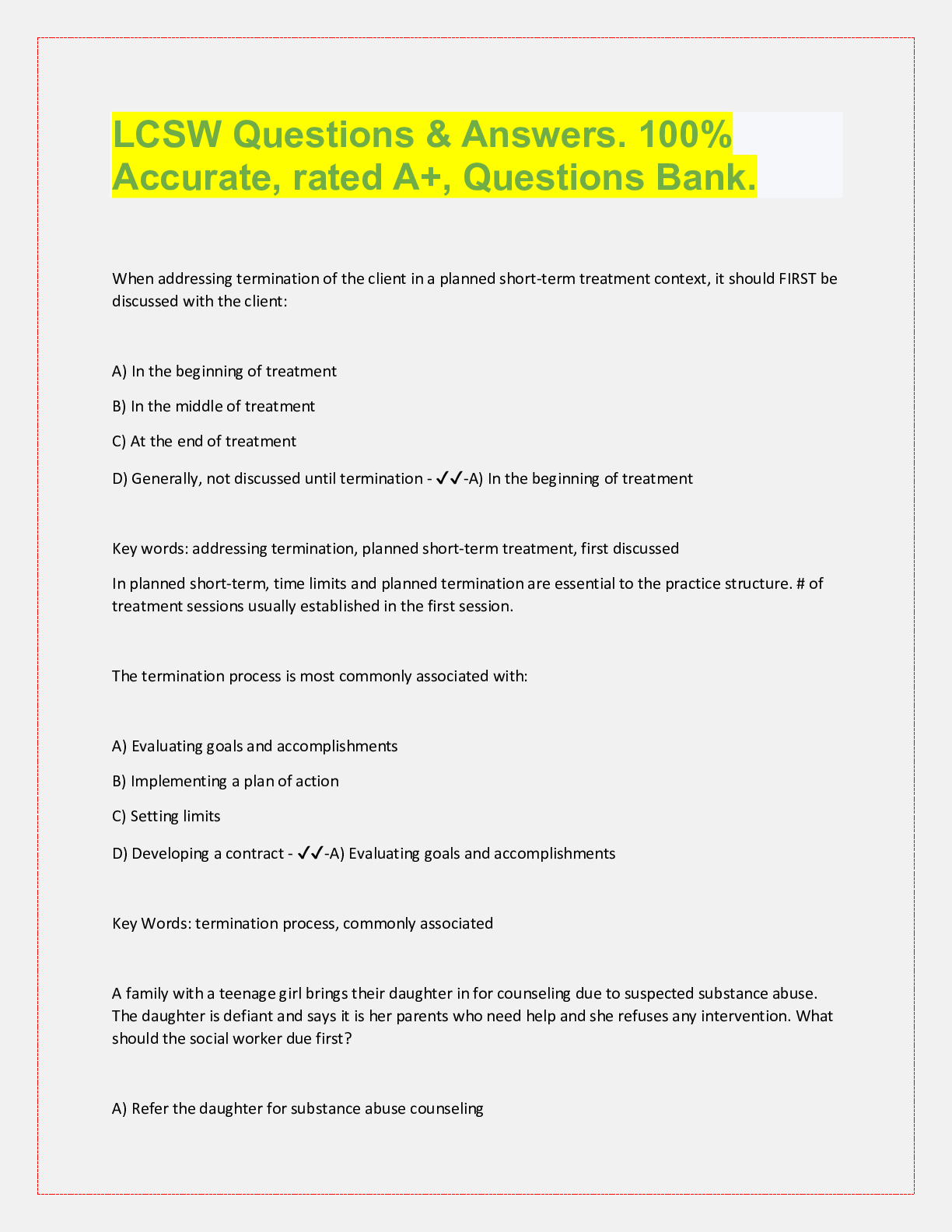
Buy this document to get the full access instantly
Instant Download Access after purchase
Buy NowInstant download
We Accept:

Reviews( 0 )
$14.00
Can't find what you want? Try our AI powered Search
Document information
Connected school, study & course
About the document
Uploaded On
Mar 15, 2023
Number of pages
168
Written in
Additional information
This document has been written for:
Uploaded
Mar 15, 2023
Downloads
0
Views
117

